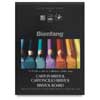 How do I decide which board to use? Consider three factors. First of all, are you choosing a surface only for scanning or reproduction, or do you intend to save and display the artwork itself? Secondly, do you need a smooth surface or a more textured surface? Finally, what weight should the board that backs the surface be? What is the difference between bristol board and illustration board? Bristol provides two working surfaces, front and back. Illustration board is only finished on one surface. Although the two can be used interchangeably in some applications. a bristol board is usually lighter in weight and is intended for longer term use and preservation. The better quality bristol boards are archival. An illustration board is intended as a surface for creating artwork that will be scanned or reproduced onto other mediums. What is the difference between a hot press and a cold press surface? Hot press board is smoother, and is generally slightly more expensive for a given size and weight. Artists who work with airbrush, markers, or pen-and-ink often favor a hot press surface. Hot press boards produce sharper and finer lines. Graphic design applications also tend to favor a hot-press surface, especially when adhesive wax, adhesive film, rubber cement, or transfer lettering is used. Hot press board scans better. Sharper detail can be reproduced from its smooth surface. Cold press board is slightly textured, and is usually favored when a brush is used, as for watercolor, gouache, acrylic, and tempera. Artists who work in a drawing medium that requires some "tooth" to the surface, such as charcoal, crayon, or pastel, also tend to prefer cold press. Calligraphers and graphite and colored pencil artists choose either surface, depending on personal preference. What is the difference between a plate and a vellum surface? These terms are used with bristol board, but not illustration board. A plate surface is roughly equivalent to hot press, while a vellum surface is roughly equivalent to cold press.
How is the weight of a board stated or measured? Both bristol and illustration boards are rated by the number of layers or "ply" of the board, however the two are not equivalent. Illustration board tends to be thicker and heavier, especially the professional quality boards, reflecting the handling that a finished illustration or mechanical may receive before it is finally approved and used for reproduction. The heaviest bristol, usually a 5-ply board, is roughly equivalent to a medium weight or 14-ply illustration board. Is the number of ply equivalent to the thickness of the board? The thickness of bristol and illustration boards, for a given number of ply, are not equivalent. The thickness of a given number of ply for a given type of board, such as a 4-ply bristol or a 14-ply illustration board, differs slightly by the type or grade of board, and by the manufacturer. Do I need a bright white or coated surface? Some illustration boards, especially hot press boards, have bright white or coated surfaces, for higher contrast. These surfaces can aid with scanning and reproduction, but their brightness is probably not helpful in viewing, displaying, and visualizing the work in progress, since it is likely to be reproduced onto a more conventional white surface. How do these boards differ from posterboard and tag board? Posterboard is used for temporary signs and displays, and as a surface for children's work, but it is not a suitable medium for reproduction or for permanent works of art. It is less costly than bristol or illustration board, and is available in many colors. Tag board is a heavy paper that is equivalent to a lighter posterboard. How do these boards differ from chipboard and matboard? Although they can be used as a surface for finished works, chipboard and matboard are really meant for backing or mounting other works of art. They tend to be much heavier. Bristol provides two working surfaces, front and back. Illustration board is only finished on one surface. Although the two can be used interchangeably in some applications. a bristol board is usually lighter in weight and is intended for longer term use and preservation. The better quality bristol boards are archival. An illustration board is intended as a surface for creating artwork that will be scanned or reproduced onto other mediums. ◦Bienfang Bristol Board Pads
◦NEW! Canson Student Bristol Board
◦Canson Student Bristol Vellum Finish Pad
◦Rising Artist Bristol Board
◦Strathmore 300 Series Bristol Board Pads
◦Strathmore 400 Series Bristol Board
◦Strathmore 400 Series Bristol Pads
◦Strathmore 500 Series Bristol Board
◦Strathmore Vellum Bristol ◦Blick Student Grade Illustration Board
◦Crescent No. 1 Cold Press Illustration Board
◦Crescent No. 100 Cold Press Illustration Board
◦Crescent No. 110 Cold Press Illustration Board
◦Crescent No. 16 Cold Press Illustration Board
◦Crescent No. 300 Cold Press Illustration Board
◦Crescent No. 310 Cold Press Illustration Board
◦Crescent No. 99 University Grade Cold Press Illustration Board
◦Letramax 2200 Cold Press Illustration Board
◦Nielsen Bainbridge Cold Press Illustration Board
◦Strathmore 500 Series Cold Press Illustration Board ◦Crescent Hi-Line Hot Press Illustration Board
◦Crescent No. 20 University Grade Illustration Board
◦Crescent No. 200 Hot Press Illustration Board
◦Crescent No. 201 Hot Press Illustration Board
◦Crescent No. 215 Hot Press Illustration Board
◦Nielsen Bainbridge Hot Press Illustration Board ◦Art Spectrum Colourfix Multi-Media Painting Board
◦Crescent Watercolor Board
◦Fredrix Archival Watercolor Canvas Boards
◦Letramax 2000 Ruling Mechanical Board
◦Multimedia Artboard http://www.dickblick.com/categories/artboards/#hotpressillustrationboard
| 